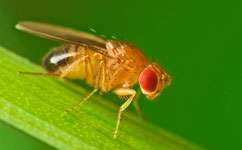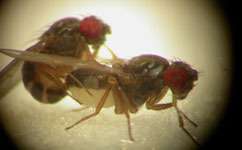Promiscuous females are trying to avoid selfish genes

So-called 'selfish genes' may make females more promiscuous and also lower male fertility.
We don't yet understand why some females mate with more than one partner, known as polyandry, - but one theory is that it can increase their chances of being fertilised by a male with healthy genes.. Males with these selfish genes have lower sperm counts and so cannot compete with their healthier rivals.
Prof Nina Wedell, author of the study, from the University of Exeter says: 'Polyandry has received an awful lot of attention, but I think there is an understudied aspect that has to do with selfish genes.'
Selfish genetics elements (SGE's) are sections of DNA that replicate to the detriment of others. Some SGE's are symbiotic and benefit the host, like mitochondria, which are organelles that live in a cell and give it energy. But some act like viruses and cause mutations that can seriously damage their host.
The measure of success for selfish genetic elements is whether they can survive into the next generation. They often target processes, such as sperm production, to do this.
'Targeting sperm production is good because of the high replication rates; there are tonnes of sperm being produced so this process is vulnerable to being high-jacked by SGE's.'

She continues: 'This way of transmitting themselves means they manipulate the sperm, which often results in low sperm counts as a side effect, affecting the fertility and competitive sperm ability of carrier males.'
The SGE's are generally undetectable before a female chooses her mate. If a female has a high chance of mating with a low-fertility male with SGEs, over a high-fertility male without them then a simple solution is to mate several times.
This way sperm from males with SGE's has to compete with a large number of sperm from healthier males for access to her eggs. It's likely that the sperm from a male with higher fertility will win, so promiscuous females have a lower risk of being fertilised by males with SGE's.
Females who mate multiply do far better than females who don't, which favours polyandry.
'If you think of it from the point of view of an SGE, if you're in a population where females mate several times you have a lower prospect of being passed around,' explains Wedell. 'An SGE doesn't want to be too detrimental, it needs something which will be sufficiently good to transmit itself but not so bad it screws up male fertility altogether.'
These selfish genes can also cause problems for conservation. To promote their reproduction, they often distort the ratio of males to females in a population. In one of the flies that Wedell looked at, gender is defined in the same way as humans – females have XX chromosomes and males XY. One SGE resides on the X chromosome of these flies.
If the males have this gene present it increases the number of X chromosomes by killing all Y sperm, so males that pass on the selfish X chromosome only have daughters.
Eventually, the entire population would be female and unable to reproduce, causing its own extinction. But, Wedell explains: 'because half their sperm were bumped off the male does very poorly in sperm competition, and does very badly in promoting this sex distortion.'
SGE's are present in all organisms, including humans, but this doesn't mean we should be promoting promiscuity among human women.
'The reasons that people have children are very different to the reasons a fly does – we're interested in quality over quantity,' explains Wedell. 'Although, if a man has these selfish genes, his fertility can be reduced so their presence may partly explain the reason that some couples are unable to have children.'
More information: Wedell, N. 2013 The dynamic relationship between polyandry and selfish genetic elements. Phil. Trans. R. Soc. B 368, 20120049. doi:10.1098/rstb.2012.0049
Provided by PlanetEarth Online
This story is republished courtesy of Planet Earth online, a free, companion website to the award-winning magazine Planet Earth published and funded by the Natural Environment Research Council (NERC).

















